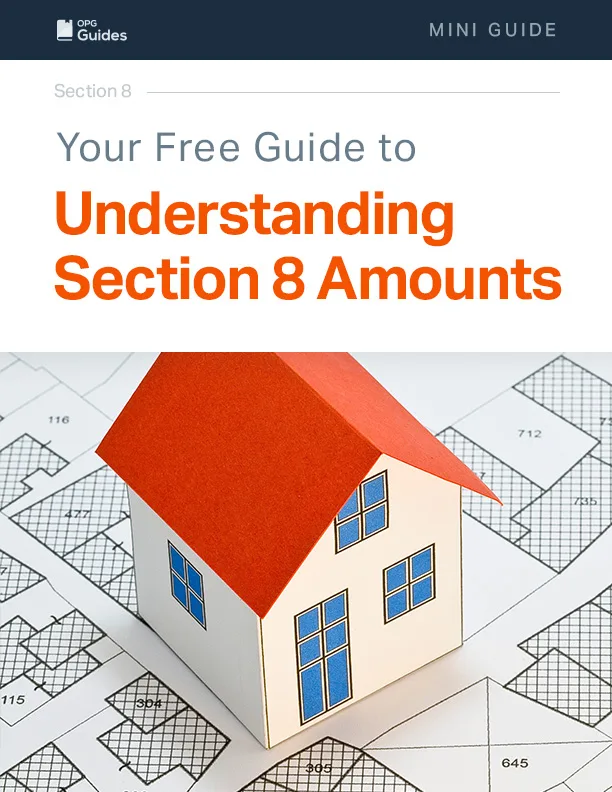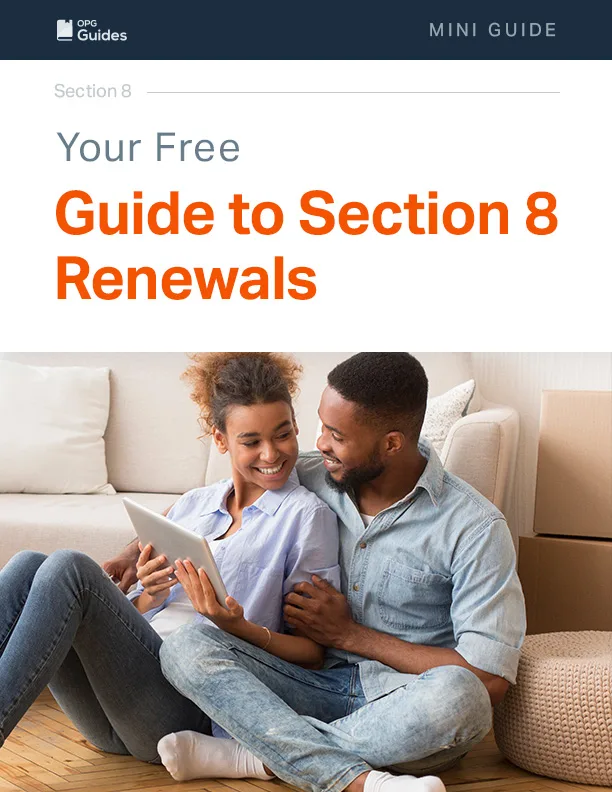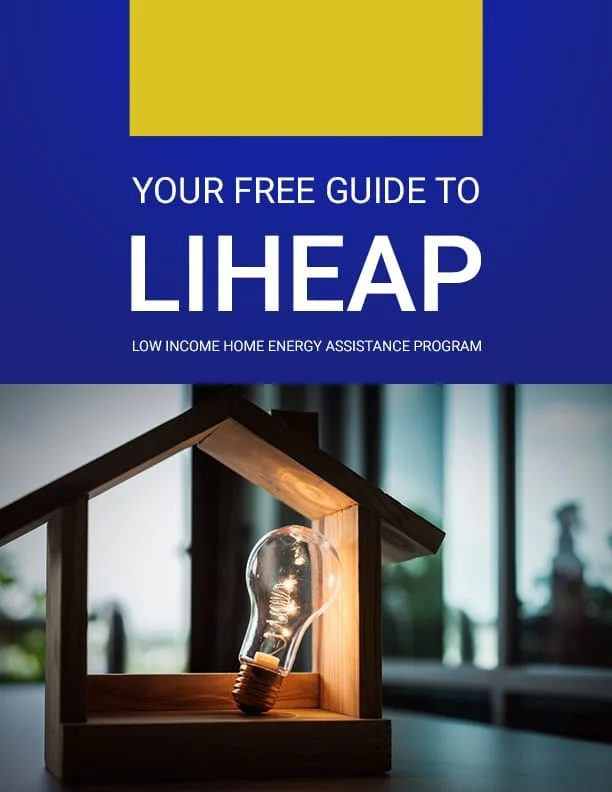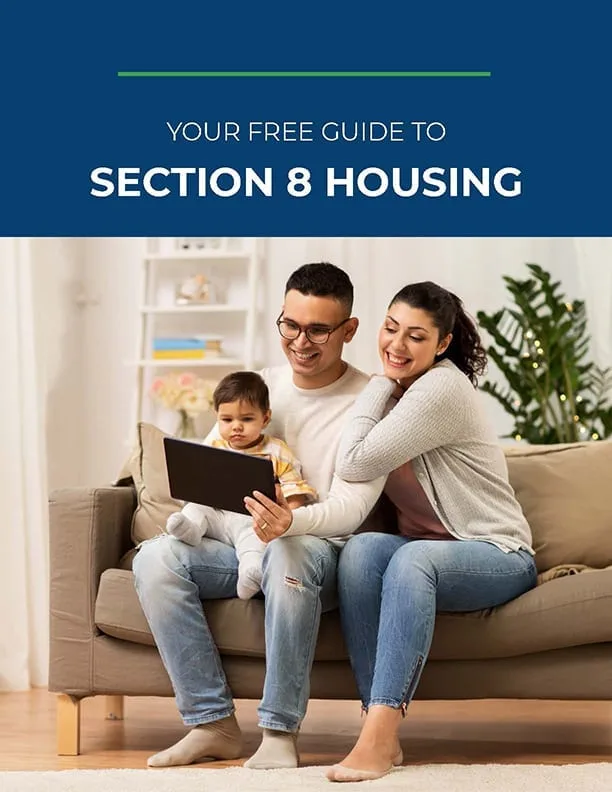Your Free Guide to Section 8 FAQs
Your Free Guide to Section 8 FAQs
We are privately owned and not affiliated with the government in any way or form.

The Section 8 Housing Assistance Program
- What is Section 8?
The Section 8 program, officially known as the Housing Choice Voucher (HCV) program, is a federal housing assistance initiative aimed at providing affordable housing options for low-income individuals and families. It was established as part of the Housing and Community Development Act of 1974. It aimed to replace the previous public housing approach with a more market-based solution.
Administered by local Public Housing Authorities (PHAs), the program allows eligible participants to receive vouchers that help cover a portion of their monthly rent. This assistance enables recipients to access safe, decent, and sanitary housing in the private rental market.
The program’s primary goal is to lessen the housing cost burden on those who may otherwise struggle to find suitable housing due to financial struggles.
- How does the Section 8 program work?
The Section 8 program functions by subsidizing a portion of the rent for eligible participants. Once approved, individuals or families receive a housing voucher that outlines the maximum amount the program will contribute toward their rent.
In most cases, approved applicants are placed on a waiting list. This is because there is far more demand for assistance than there are suitable homes.
When they reach the top of the waiting list, they can search for housing units in the private market that meet the program’s safety and quality standards.
Once a suitable unit is found, the landlord and the PHA enter into a contract. The tenant pays a portion of the rent directly to the landlord, while the PHA pays the remainder of the rent directly to the landlord on behalf of the tenant.
- What is the difference between the Housing Choice Voucher (HCV) program and Project-Based Voucher (PBV) program?
The Housing Choice Voucher (HCV) program and the Project-Based Voucher (PBV) program are both part of the Section 8 initiative, but they differ in how the housing assistance is applied. HCV allows participants to choose any eligible private rental unit, and the voucher amount adjusts to the unit’s rental price as long as it meets quality standards.
In the PBV program, housing assistance is tied to specific units within a property. This means that if you live in a PBV unit and move, the assistance typically does not move with you.
- What is the role of the local Public Housing Authority in the Section 8 program?
PHAs play a central role in administering the Section 8 program at the local level. They determine eligibility, process applications, and manage waiting lists.
PHAs also inspect rental units to ensure they meet housing quality standards, negotiate rental agreements with landlords, and disburse housing assistance payments on behalf of participants.
- Are there any time limits on how long I can receive Section 8 assistance?
Unlike some other housing assistance programs, there are no strict time limits on receiving Section 8 assistance. You can generally continue to receive assistance as long as you meet the program’s eligibility criteria.
- Can I use my Section 8 voucher to buy a home instead of renting?
While the Section 8 program primarily supports rental housing, some PHAs offer homeownership programs to help participants transition from renting to owning. These programs are less common and have specific eligibility requirements.
Eligibility for Housing Assistance

- Who can qualify for Section 8?
Eligibility for the Section 8 program is primarily determined by:
- Income
- Family size
- U.S. citizenship or eligible immigration status.
Generally, applicants must have an income that falls below a certain threshold, which is often set at 50% of the median income for the area. Family size is also taken into account, and preference might be given to families with children, seniors, or individuals with disabilities.
Additionally, applicants must usually meet other criteria, such as passing background checks and having a good rental history. It’s important to note that each local PHA manages its own waiting list and may have specific requirements, so applicants should contact your local PHA for accurate information.
- What are the income limits for Section 8 eligibility?
Income limits for Section 8 eligibility vary based on factors such as family size and the area’s median income. The U.S. Department of Housing and Urban Development (HUD) establishes income limits for different regions, and applicants must have an income that is below the designated limit for their household size.
The goal is to ensure that the program assists those with the greatest financial need. Some PHAs might also consider preferences for certain groups, such as veterans or individuals with disabilities, when prioritizing applicants from the waiting list.
- Can non-citizens, such as immigrants, receive Section 8 assistance?
Non-citizens who have eligible immigration status, such as refugees or individuals with certain visas, can be eligible for Section 8 housing assistance. The program is designed to support those in need, regardless of citizenship status.
Applying for Vouchers
- Where do I apply for Section 8?
To apply for Section 8 housing, you need to complete an application through your local PHA when the waiting list is open. Application periods can be limited, and wait times can be extensive due to high demand. Applications typically require information about household composition, income, and housing preferences.
Once on the waiting list, you should keep your contact information up to date and be prepared to provide any required documentation when contacted by the PHA. It’s important to note that being placed on the waiting list does not guarantee immediate assistance, and the wait times can vary significantly depending on the area.
- How are rental voucher amounts determined?
The calculation of rental voucher amounts under the Section 8 program takes several factors into consideration. Primarily, the voucher amount is based on the family’s income and the area’s Fair Market Rent (FMR), which is determined by HUD.
- How much rent will I have to pay if I have a Section 8 voucher?
As a Section 8 participant, the PHA designates your rent payment to be a percentage of your income. However, there are minimum rent requirements to prevent voucher amounts from being too low.
Typically, families contribute about 30% of their adjusted gross income towards rent, and the voucher covers the difference. This means that if your income increases, your rent portion may also increase, but it will remain a reasonable portion of your earnings.
The Fair Market Rent (FMR) serves as a baseline reference for the total rental cost of the unit you choose. If the unit’s rent exceeds the FMR, you may be responsible for paying the additional amount beyond the 30% of your income.
- How long does it take to get a voucher?
The time it takes to receive a voucher can vary significantly depending on a range of factors. The demand for affordable housing, the availability of funding, and the specific procedures of your local Public Housing Authority (PHA) all contribute to the timeline. Here are some key points to consider:
- Waiting List: Most PHAs have waiting lists for Section 8 vouchers due to high demand. The length of these waiting lists can vary widely.
- Application Periods: PHAs typically open their waiting lists for new applications periodically. These application periods might occur annually or less frequently. If you apply during an open period, your wait time may be shorter compared to those who apply later.
- Preferences: Some PHAs have preferences for specific groups, such as veterans, elderly individuals, or people with disabilities. If you fall into one of these preference categories, you might move up the waiting list more quickly.
- Local Housing Market: The availability of suitable housing units can affect how quickly vouchers are distributed. In areas with a limited supply of affordable housing, the wait for a voucher might be longer.
- Funding: The availability of funding from the federal government plays a significant role. If funding is limited, the PHA might have a smaller number of vouchers to distribute, leading to longer waiting times.
- Changes in Family Circumstances: If your family size or income changes while you’re on the waiting list, it could impact your priority or eligibility status. It’s important to update the PHA about any changes.
- Local PHA Practices: Each PHA operates independently and may have its own procedures and timelines for distributing vouchers.
Waiting Lists

- What is the waiting list?
The Section 8 waiting list refers to a list of individuals and families who have applied for housing assistance but have not yet been awarded a voucher. Because the demand for affordable housing often exceeds the availability of vouchers, many PHAs maintain waiting lists to manage the allocation of vouchers fairly and efficiently.
It’s important to note that the waiting list is not a guarantee of receiving a voucher. The availability of vouchers depends on factors like funding, turnover of existing participants, and local housing market conditions. Applicants on the waiting list should keep their contact information up to date with the PHA and stay informed about any updates or changes in their application status.
- How long is the waiting list for Section 8 assistance?
The waiting list duration can vary widely based on factors such as demand, available funding, and the local housing market. Some areas may have waiting lists that are open for months, while others might have lists that are closed due to a high number of applicants.
- How can I move up the waiting list?
Moving up the Section 8 waiting list involves understanding the factors that determine your position and taking certain steps to potentially improve your priority. While there’s no surefire way to expedite the process, here are some strategies that might help:
- Apply Early: The sooner you apply when the waiting list opens, the higher your chances of getting on the list early. Keep an eye on announcements from your local PHA regarding open waiting list periods.
- Meet Preferences: Some PHAs offer preferences to specific groups, such as veterans, elderly individuals, or people with disabilities. If you fall into one of these preference categories, you might move up the list more quickly. Make sure to provide any required documentation to verify your eligibility for these preferences.
- Keep Information Updated: Notify the PHA of any changes in your contact information, family size, or income. Changes in circumstances might impact your priority or eligibility status, so it’s crucial to keep your application current.
- Respond Promptly: If the PHA contacts you with information or requests, respond promptly. Failure to respond within specified time frames might result in your application being set aside or removed from the list.
- Maintain Accurate Documentation: Ensure that all the information you provide on your application is accurate and well-documented. Inaccuracies can lead to delays or removal from the waiting list.
- Explore Other Housing Options: While waiting for a Section 8 voucher, consider exploring other affordable housing options that might be available in your area. This could help alleviate your housing needs while you’re on the waiting list.
- Are there preferences given to certain individuals or families on the waiting list?
Some PHAs offer preferences to specific groups like veterans, the elderly, or individuals with disabilities. These preferences can impact waiting list placement and prioritize those who need housing assistance the most.
- Can I check the status of my Section 8 application or waiting list placement?
After applying for Section 8 housing, you can usually periodically check your application status with your local PHA. This helps you stay informed about your position on the waiting list and any updates regarding your application. PHAs might provide online tools or phone lines for you to inquire about your status.
Participating in the Section 8 Program
- What kind of home can I live in with a Section 8 voucher?
With a Section 8 voucher, you have flexibility in choosing the type of home you can live in, provided it meets certain guidelines set by the program. Here are some key points to consider:
- Private Rental Units: The HCV program allows you to rent from private landlords. This means you have the flexibility to choose from a variety of housing options, including apartments, single-family homes, townhouses, and duplexes.
- Unit Requirements: The unit you choose must meet the Housing Quality Standards established by the program. These standards cover aspects such as safety, sanitation, and overall condition. The PHA will conduct an inspection to ensure the unit meets these standards before you can move in.
- Fair Market Rent: The FMR, determined by your local PHA, sets a baseline for the maximum rent amount the program will cover. You can choose a unit with a rent that falls within this limit, and the program will subsidize the difference between the FMR and your portion of the rent.
- Landlord Agreement: The landlord must agree to participate in the Section 8 program. This involves signing a lease agreement and accepting the housing voucher as part of the rent payment. The lease should outline the terms and conditions of the tenancy.
- Choice and Location: You have the freedom to choose where you want to live within the limitations of the program’s guidelines. Keep in mind that the availability of units and the rental market conditions in your desired area can impact your options.
- Rental Responsibilities: As a tenant, you’re responsible for paying your portion of the rent on time, complying with the lease terms, and maintaining the unit in good condition. The landlord is responsible for maintaining the property according to the lease agreement and program requirements.
Units need to meet safety, health, and quality standards set by the PHA. PHAs typically conduct inspections to ensure that prospective units meet these standards before a rental agreement can be approved.
Landlords must also comply with the rules and regulations set forth by the program, including charging a reasonable rent amount and adhering to the lease terms and conditions. This ensures that participants have access to suitable, well-maintained housing options.
- Can I choose an apartment with rent higher than the Fair Market Rent established by HUD?
Yes, you can choose an apartment with a rent higher than the FMR when you have a Section 8 voucher. However, there are some important factors to consider:
- Tenant Responsibility: If you choose a rental unit with a rent higher than the FMR, you will be responsible for paying the additional amount beyond the FMR. Your portion of the rent is calculated based on approximately 30% of your adjusted gross income, so the excess rent will come from your own funds.
- Affordability: While you have the option to select a unit with a higher rent, it’s essential to ensure that the total rent, including your portion and the amount beyond the FMR, remains affordable and within your budget.
- PHAs and Local Policies: Some PHAs might have specific guidelines or limits on how much rent can exceed the FMR. It’s important to check with your local PHA to understand any local rules or recommendations regarding renting units above the FMR.
- Reasonable Rent: HUD and PHAs consider the concept of “reasonable rent” when assessing the rent amount for a unit. While the program allows flexibility, the rent must still be reasonable compared to similar units in the area. If the rent is considered unreasonably high, the PHA might choose not to approve the unit.
- Housing Quality Standards: Regardless of the rent amount, the rental unit must meet the HQS set by the Section 8 program. The unit needs to pass inspection to ensure that it is safe, sanitary, and in good condition.
Before choosing a rental unit with a rent higher than the FMR, it’s advisable to carefully evaluate your budget, income, and the overall cost of living in the area. Discuss your options and potential expenses with your local PHA to make an informed decision that aligns with your financial circumstances.

- What happens if I’m dissatisfied with the quality of the housing I’m renting through the Section 8 program?
If you are a Section 8 participant who is dissatisfied with the quality of your rental unit, you can report your concerns to the PHA. The PHA can conduct inspections and require landlords to address any violations of housing quality standards.
- What happens if my income or family composition changes while in the Section 8 program?
Reporting changes in income or family composition to the PHA is crucial to ensure accurate assistance calculations. These changes might lead to adjustments in rental voucher amounts or eligibility.
- Can I be evicted from a Section 8 rental unit?
Similar to any other rental arrangement, you can face eviction from a Section 8 unit if you violate the terms of your lease or program rules. The PHA and the landlord have the authority to enforce these rules to maintain the integrity of the program.
- Can I move and keep my voucher?
Yes, you can move and take your voucher with you. This is known as portability. The process involves transferring your voucher from your current PHA to a new one in the area you’re relocating to. It’s important to coordinate with both PHAs and comply with your guidelines to facilitate a smooth transition.
- What happens if I move to a new house?
If you have a Section 8 voucher and you’re considering moving to a new house or rental unit, there are several steps and considerations to keep in mind. Here’s what typically happens when you decide to move:
- Notify Your PHA: The first step is to notify your local PHA about your intention to move. You’ll need to inform them of your plans and provide details about the new rental unit you’re considering.
- Check Voucher Portability: If you’re moving to a different city or state, you’ll need to inquire about voucher portability. Portability allows you to transfer your voucher from your current PHA to a new one in your destination area. Both your current and prospective PHAs need to coordinate this process.
- Inspection and Approval: Before you move, the new rental unit must meet the HQS set by the program. Your prospective landlord will need to allow the PHA to inspect the unit to ensure it meets the required standards. Once the unit passes inspection, it can be approved for the Section 8 program.
- Lease Agreement: You’ll need to sign a lease agreement with your new landlord, just as you would in any rental situation. The lease should outline the terms and conditions of the tenancy, including the rent amount, lease duration, and responsibilities of both parties.
- Rent Calculation: The PHA will recalculate the rent based on the rent amount for the new unit and your adjusted income. Your portion of the rent may change, depending on factors like the FMR for the new area and your income.
- PHA Coordination: If you’re transferring your voucher to a new PHA, both the current and new PHAs need to coordinate the transfer. They will work together to ensure a smooth transition and the accurate transfer of housing assistance payments.
- Notice to Current Landlord: If you’re leaving your current rental unit, you’ll need to provide proper notice to your current landlord in accordance with your lease agreement and local laws.
- Update Contact Information: Make sure to update your contact information with both your current and new PHAs to ensure that you receive important updates and information about your housing assistance.
It’s important to note that the process of moving with a Section 8 voucher can vary depending on factors like your current location, the new rental unit’s location, and the specific policies of your PHA. Communication with your PHA is key to ensuring a successful and compliant transition to your new housing arrangement.
- Can I transfer my Section 8 voucher to a different state?
Transferring a voucher between states, known as portability, is possible within the Section 8 program. It involves coordinating with the current and receiving PHAs to ensure a seamless transition. The process helps participants maintain your assistance even when they relocate.
- What are the responsibilities of a Section 8 landlord?
Landlords in the Section 8 program are responsible for maintaining your properties according to HUD’s Housing Quality Standards. They need to perform necessary repairs and provide safe living conditions. They also need to comply with the terms of the lease and the housing assistance payment contract with the PHA.
- Maintain Housing Quality: Landlords must ensure that their rental units meet the Housing Quality Standards (HQS) set by the PHA. These standards cover a range of factors, including safety, sanitation, and overall condition. Regular maintenance and prompt repairs are necessary to keep the rental unit in compliance with these standards.
- Accepting the Voucher: Landlords need to be willing to accept housing vouchers as a portion of the rent payment. The voucher covers the difference between the tenant’s contribution and the Fair Market Rent (FMR) determined by the PHA. It’s important for landlords to understand how the payment process works and to communicate clearly with the PHA about any changes in rent or tenancy.
- Lease Agreement: Landlords must establish a lease agreement with the tenant that outlines the terms and conditions of the tenancy. The lease should align with program requirements and adhere to all applicable local and state laws. The lease should also include any specific responsibilities of both the landlord and the tenant.
- Screening and Fair Treatment: Landlords have the right to screen potential tenants for suitability, but they must also adhere to fair housing laws and not discriminate against voucher holders. Denying a tenant solely based on your use of a housing voucher is considered discriminatory in many jurisdictions.
- Security Deposit: Landlords may collect a security deposit from Section 8 tenants as they would with any other tenant. The terms for the security deposit, including its return at the end of the lease, should be clearly outlined in the lease agreement.
- Communication with PHA: Landlords need to maintain open communication with the PHA. This includes providing necessary information for rental unit inspections, promptly addressing any tenant or property-related concerns raised by the PHA, and reporting any changes in tenancy status.
- Termination of Lease: If a landlord intends to terminate a lease with a Section 8 tenant, they must follow the appropriate legal procedures and notify both the tenant and the PHA in accordance with the lease terms and local laws.
- Can landlords refuse Section 8 vouchers?
In some locations, landlords have the option to accept or decline Section 8 vouchers. This practice is called source-of-income discrimination and is prohibited in certain jurisdictions. The aim is to prevent discrimination against voucher holders and ensure equal access to housing.






